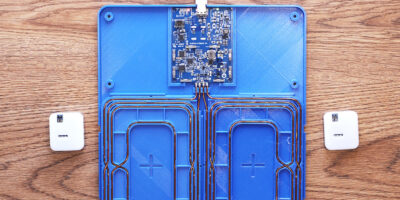For product categories that are using RF and inductive charging, NuCurrent has launched NuEva (high frequency) HF development platform based on inductive resonant power transfer.
“There are a great number of product categories that aren’t well-served by RF and inductive charging,” said NuCurrent’s CEO, Jacob Babcock. “NuEva HF delivers power levels about 1,000 times higher than RF and it provides positioning flexibility about 100 times that of Qi,” he said. It can also charge multiple devices simultaneously.
The NuEva HF platform operates at 6.78MHz, the same frequency as the standard developed by the AirFuel Alliance. In addition to multi-device charging from a single transmitter, greater spatial freedom and positioning flexibility, the HF method of power transfer delivers high system efficiencies and uniform charging zones and up to 300W power.
“NuEva HF represents a generational leap forward for inductive resonant power transfer,” said Babcock. It is intended for a range of applications, from gaming and robotics to personal transportation and medical devices, using wireless power.
NuEva HF offers several patented and proprietary technologies developed by NuCurrent. Among these innovations is face “repeater” technology which extends charging surface areas using inexpensive passive electronics driven from a single power source.
There is also multi-layer, multi-turn (MLMT) antennae that increase efficiencies and lower thermals and a variety of methods for cost-effective EMI mitigation, said NuCurrent.
The in-band communications reduce system cost, compared to Bluetooth, claims NuCurrent and there are is added flexibility for siting, with options for power transfer through a variety of materials (e.g. metal, tissue).
NuCurrent supplies developers with wireless power technologies and product integration expertise. Core technologies span magnetics, software and systems simulation. The company has generated over 150 patents granted and pending globally. It also offers internal tools to enhance speed to market, improve product performance and mitigate major development risks. The company says that its systems integration expertise supports manufacturers of appliances, smartphones, wearables, hearables, consumer electronics, medical devices, robotics, IoT, sporting equipment and other emerging product categories.
NuCurrent solutions are based on inductive and inductive resonant wireless power transfer which offers convenience, safety, efficiency, and enhanced user experience.







